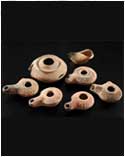

The Epipaleolithic period is best understood in the southern Levant, i.e. Israel, Jordan and the Sinai Peninsula. The period is one of transition from nomadic hunter-gatherers to sedentary farmers. Small flint tools known as ‘microliths’, which were discovered in numerous sites of the period, indicate considerable cultural diversity. It seems that territorial boundaries existed during the Early and Middle Epipaleolithic, each occupied by a number of small groups with common technological tradition.
The period is divided into three phases:
Early Epipaleolithic (24,000–18,000 BP)
Middle Epipaleolithic (18,000–14,500 BP)
Late Epipaleolithic (14,500–11,800 BP)
The Early Epipaleolithic period is characterized by the Kebaran, Nebekian, Qalkhan and Nizzanan cultures. The Kebaran culture was first defined in Kebara Cave, Mt. Carmel. The most distinctive characteristics of its assemblages are backed microliths, Kebara points and the first appearance of mortars and grindstones. Kebaran assemblages are found mainly in the Mediterranean regions, while Nebekian, Qalkhan and Nizzanan sites, concentrate in desert areas. In addition to flint-tools industry, huts and related architectural features are found in a number of open-air sites.
The Middle Epipaleolithic period is characterized by the Geometric Kebaran, Mushabian and Ramonian cultures. The Geometric Kebaran assemblages are common throughout the Levant, from the Euphrates Valley to the Sinai Peninsula. They are characterized by geometric microliths such as trapezes and rectangles, as well as by elongated end-scrapers. The Mushabian and the Ramonian sites are confined to the desert areas of the Negev and the Sinai Peninsula.
The Late Epipaleolithic period is characterized by mild climate — an increase in precipitation along with fairly low temperatures. This and other factors led to the emergence of the Natufian culture, which is associated with the earliest farmers. The Natufian culture was originally defined at Shuqba cave, in Wadi Natuf, Samaria. The assemblages are characterized by a variety of flint tools: microliths, lunates (sometimes with bifacial, Helwan retouch), burins and awls/borers, as well as by sickle blades, which appear for the first time during this period. Another typical aspect of the Natufian culture is the high frequency of art objects, bone and horn tools, pendants and beads made of animal teeth, Marin shells and stone. Ground stone tools such as bedrock mortars, mobile mortars, bowls, pestles, and cup marks occur in large quantities during this period. The Natufian period is subdivided into Early and Late Natufian on the basis of the flint-tools industry. The Early Natufian settlements are found mainly in the central Levant. In general, Natufian sites are small or medium-size villages, with round and D-shaped structures, which contain burials accompanied by grave-goods. A famous example is the burial of a woman with a dog that was uncovered at the site of Einan in the Hula Valley. Late Natufian settlements are more restricted in their geographic distribution and demonstrate decline in the quality of construction and in the quantity of art objects. In the Negev and the Sinai Peninsula, the Harifian culture existed side by side with the Late Natufian. The flint tools that are typical of this culture are the Harifian points, lunates with abrupt retouch, blades, end-scrapers and borers. Round structures were found in the Harifian settlements. These commonly feature bedrock mortars and large grinding slabs. The known assemblages seem to indicate a hunter-gatherers society.
|







